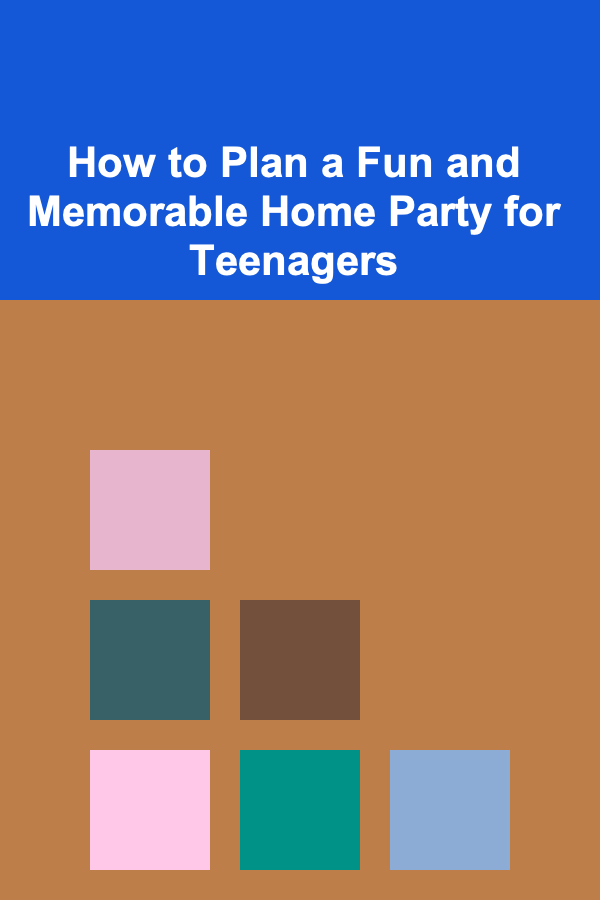
How to Plan a Mixed Media Art Journal
ebook include PDF & Audio bundle (Micro Guide)
$12.99$8.99
Limited Time Offer! Order within the next:
Not available at this time

Creating a mixed media art journal is an exciting, therapeutic, and creative process. It offers an opportunity to explore a variety of artistic techniques and materials in a single, unified space. Whether you're a seasoned artist or a beginner, the beauty of a mixed media journal lies in its flexibility and the personal expression it allows. From using paint, fabric, and paper to stencils, stamps, and digital elements, mixed media art can help you to discover new techniques and express your inner thoughts and emotions.
This guide will walk you through the process of planning and creating your own mixed media art journal. We will explore the essentials of setting up your journal, the types of materials you can use, and how to plan and execute a page. With thoughtful planning, your mixed media journal will not only become a collection of artistic techniques but a visual storybook of your personal journey.
Understand the Basics of Mixed Media Art Journaling
Before you dive into creating your mixed media art journal, it's important to understand what mixed media art is. At its core, mixed media art involves combining different materials and techniques in one piece of art. The idea is to create a textured, layered composition that tells a story or evokes a feeling. In an art journal, this concept is applied to each page, allowing for a free-flowing exploration of creativity.
1.1 What Makes Mixed Media Unique?
The mixed media approach allows you to use a variety of materials, from traditional paint and ink to unconventional items like fabric, metal, or natural materials. Here's a breakdown of what makes mixed media different:
- Layering: A key characteristic of mixed media is the layering of materials, which adds texture and depth to your artwork.
- Freedom: There are no strict rules in mixed media art. You're encouraged to experiment with different styles and methods.
- Personal Expression: Mixed media art often reflects the artist's emotions, ideas, or experiences, making it a deeply personal and expressive form of art.
1.2 Why Start a Mixed Media Art Journal?
An art journal serves as a visual diary where you can explore, practice, and develop your creative skills. Starting a mixed media art journal is an excellent way to:
- Explore Creativity: An art journal is a safe space to try new techniques and materials without worrying about the outcome.
- Emotional Expression: Many artists use their journals to express their emotions, process experiences, or explore their thoughts in a more visual way.
- Practice Skills: Art journals are perfect for practicing new techniques or experimenting with different styles, whether you're an experienced artist or just starting out.
- Create a Personal Archive: Over time, your journal will become a visual archive of your personal journey, filled with memories, thoughts, and creative expressions.
Gathering Materials for Your Mixed Media Art Journal
The first step in planning your mixed media art journal is gathering the materials you'll need. One of the beauties of mixed media is the vast array of materials you can use, so the possibilities are endless. Below are some essential supplies you can include in your mixed media toolkit.
2.1 Choosing the Right Journal
The journal you choose will serve as the foundation for your mixed media art. You want a journal that can handle multiple layers of materials without falling apart or warping. Consider the following:
- Paper Type: Look for heavy, thick paper that can withstand wet media (like paint, ink, or glue). Mixed media paper or watercolor paper is a good choice.
- Size: The size of the journal is entirely up to you. Some artists prefer small journals for portability, while others enjoy larger journals for expansive artwork.
- Binding: Choose a binding type that suits your needs. Spiral-bound journals allow you to fold the pages back for easier access, while stitched bindings offer a more durable option.
2.2 Paints and Inks
Painting is one of the main techniques in mixed media art. Consider a variety of paints and inks:
- Acrylic Paint: This versatile medium works well with most surfaces, dries quickly, and can be layered easily. Acrylics are often used as a base or background for mixed media pages.
- Watercolor: Ideal for creating transparent washes and soft, flowing effects, watercolor can add a delicate touch to your journal.
- Ink: Use different types of inks, such as India ink, alcohol ink, or even distress ink, to create vibrant lines, backgrounds, or textural effects.
2.3 Collage Materials
Collaging is a key element of mixed media art. Gathering a variety of materials to use in your collages will add texture and interest to your journal pages.
- Old Magazines and Newspapers: These are perfect for finding interesting textures, patterns, or images to incorporate into your pages.
- Ephemera: Items like old ticket stubs, postcards, or handwritten notes can add personal meaning and vintage charm to your pages.
- Fabric and Textiles: Scraps of fabric, lace, or even paper towels can create interesting texture when glued onto the page.
- Stamps and Stencils: These tools help you add consistent patterns, images, and designs to your artwork.
2.4 Adhesives and Mediums
You'll need adhesives to secure your collage materials and mediums to create specific effects. Consider the following:
- Mod Podge or Gel Medium: These are excellent for sealing your collages and creating a glossy finish on your artwork.
- Glue Sticks: A quick and easy adhesive for lighter materials, glue sticks are especially useful for paper and fabric.
- Double-Sided Tape: Ideal for affixing photographs, tickets, or smaller pieces of ephemera.
2.5 Other Supplies
Here are some additional materials to consider incorporating into your mixed media journal:
- Charcoal and Pastels: Perfect for adding shading, highlights, and depth to your pages.
- Markers and Pens: Use fine liners, gel pens, or markers to create outlines, doodles, or journaling.
- Washi Tape: A fun, decorative tape that can add colorful borders, frames, or accent pieces.
- Spray Paints and Mists: Add splatters or a soft misted background effect with spray paints or liquid mists.
Planning Your First Mixed Media Art Journal Page
Now that you have your materials, it's time to start planning your first mixed media art journal page. Here's a step-by-step guide to help you plan and execute a cohesive and creative page.
3.1 Choose a Theme or Concept
Start by deciding on the theme or concept of your page. Mixed media art journaling offers plenty of room for creativity, but having a focal point can help guide your process. Some theme ideas include:
- Personal Emotions: Use the page to express a particular emotion, such as happiness, sadness, or excitement. Use colors, textures, and images to evoke the feeling you want to communicate.
- Abstract Art: If you prefer to focus on colors and textures rather than specific imagery, create an abstract piece using paints, stencils, and collage materials.
- Nature or Seasons: Explore themes related to nature, such as flowers, trees, animals, or seasonal changes.
- Memory or Event: Document a significant moment or memory from your life, incorporating personal items such as photographs, tickets, or handwritten notes.
3.2 Create a Background
The background is the foundation of your art journal page. You can create it using a variety of materials, depending on the effect you're going for.
- Layer Paints: Start by layering acrylic paint or watercolor to create a colorful or textured background. You can also use spray mists for a softer effect.
- Add Texture: Use stencils, stamps, or textured papers to create dimension and depth in your background.
- Incorporate Collage Elements: Glue down magazine clippings, fabric, or other items to form the foundation of your page. These pieces will peek through and add interest to the overall design.
3.3 Add Focal Points
Once your background is set, start adding focal points to guide the viewer's eye. These could include:
- Images or Photos: Use magazine clippings, photographs, or hand-drawn elements to tell a story or highlight a particular theme.
- Text or Quotes: Add journaling or meaningful quotes using your handwriting or stamps. You can also incorporate word cutouts from magazines for a more graphic feel.
- 3D Elements: Add fabric, buttons, or other embellishments to create additional texture and dimension.
3.4 Final Touches
After you've arranged your materials and created the overall composition, it's time to finalize your page:
- Add Details: Use pens, markers, or paint to add small details like outlines, doodles, or shading.
- Seal Your Work: To protect your page and ensure longevity, apply a layer of Mod Podge or gel medium over the top. This will also give your page a glossy finish.
3.5 Let Your Page Dry
Mixed media art can involve multiple layers of materials, so it's important to allow each layer to dry fully before adding the next. This will prevent smudging and ensure the final result is crisp and vibrant.
Maintaining and Expanding Your Mixed Media Art Journal
Once you've completed a few pages, it's time to reflect and grow your journal. Here are some tips for maintaining and expanding your art journal practice:
4.1 Create a Routine
Make art journaling a part of your routine. Whether it's once a week or once a month, consistency will help you improve your skills and make art journaling a regular habit.
4.2 Experiment with New Techniques
As you continue creating, don't be afraid to experiment with new techniques and materials. Try different types of paints, explore new textures, or even incorporate digital elements into your journal.
4.3 Reflect on Your Progress
Looking back on your journal pages can be a powerful way to track your artistic growth and personal journey. Reflect on how your techniques, materials, and themes evolve over time.
Conclusion
Creating a mixed media art journal is an exciting way to express yourself through art. With endless possibilities for materials, techniques, and themes, each page becomes a unique reflection of your creative journey. By planning your pages thoughtfully and embracing experimentation, you'll develop a rich and vibrant journal that showcases your artistic growth and personal stories. So, gather your materials, let your imagination run wild, and enjoy the process of creating your own mixed media masterpiece!

How to Plan a Fun and Memorable Home Party for Teenagers
Read More
How to Save Energy While Lighting Your Home Effectively
Read More
How to Scale Your Greeting Card Business and Reach More Customers
Read More
How to Understand the Importance of Regular Check-ups
Read More
How to Get Cheap Accommodation in Major Cities
Read More
How to Build a CubeSat
Read MoreOther Products

How to Plan a Fun and Memorable Home Party for Teenagers
Read More
How to Save Energy While Lighting Your Home Effectively
Read More
How to Scale Your Greeting Card Business and Reach More Customers
Read More
How to Understand the Importance of Regular Check-ups
Read More
How to Get Cheap Accommodation in Major Cities
Read More